Additional information
| Weight | 1 lbs |
|---|---|
| Dimensions | 4 × 4 × 4 in |
| Height | |
| Blooms | |
| Color | |
| Moisture | |
| Light |
$12.00
Host Plant – Red Admiral, Eastern Comma, Question Mark Preferring wet-mesic and semi-shady sites, Boehmeria cylindrica lacks the stinging hairs of some of its nettle cousins. Stringy heads of tiny yellow-green flowers form between leaf stems in summer. Moths and butterflies are attracted to this modest plant.
Out of stock
| Weight | 1 lbs |
|---|---|
| Dimensions | 4 × 4 × 4 in |
| Height | |
| Blooms | |
| Color | |
| Moisture | |
| Light |
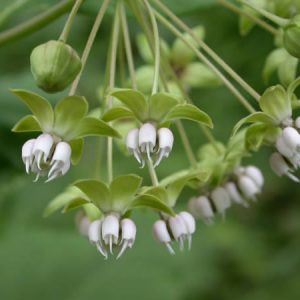
Poke Milkweed is native to Michigan and can also be found throughout the eastern portion of the United States and Canada. It is most often found at the edges of forests and upland woods and is one of the few milkweeds that prosper in shaded conditions. Tall and elegant with drooping flowers that are white with pink accents and extremely fragrant, this milkweed is a popular nectar source in addition to being a host plant for the Monarch butterfly. This is a non-aggressive milkweed and once established, plants are known to survive for decades.
Available – May 2017
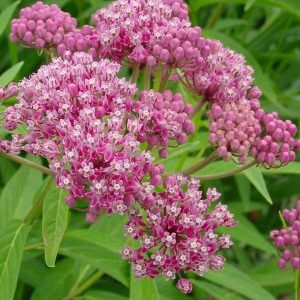
Swamp Milkweed occurs throughout most of the United States. It is a tall plant found in moist habitats such as wet meadows, floodplains, riverbanks, pond shores, stream banks, wet woods, swamps, and marshes, although it will also grow in drier areas such as prairies, fields, and roadsides. Swamp milkweed needs full sun or partial shade to flourish. Flowers are fragrant and very attractive to hummingbirds, butterflies and bees as a nectar source. Swamp milkweed is also an important food source for the larval stage of Monarch butterflies. The plants are deer resistant and heat tolerant. Also known as Rose Milkweed, Red Milkweed, and Marsh Milkweed.

Spicebush is a deciduous shrub with a broad, rounded habit which typically grows 6-12′ (less frequently to 15′) high in moist locations in bottomlands, woods, ravines, valleys and along streams. Clusters of tiny, apetulous, aromatic, greenish-yellow flowers bloom along the branches in early spring before the foliage emerges. Dioecious (male and female flowers on separate plants), with the male flowers being larger and showier than the female ones. Flowers of female plants give way to bright red drupes (to 1/2″ long) which mature in fall and are attractive to birds. Female plants need a male pollinator in order to set fruit, however. Drupes are very attractive, but are largely hidden by the foliage until the leaves drop. Thick, oblong-obovate, light green leaves (to 5″ long) turn an attractive yellow in autumn. Leaves are aromatic when crushed. The larva (caterpillar) of the spicebush swallowtail butterfly feeds on the leaves of this shrub.Lindera is named for the Swedish botanist, Johann Lindler.
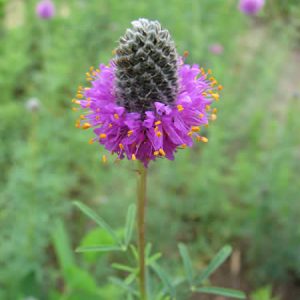
Host Plant – Sulphurs
Tiny rose-purple flowers in cylindrical, head-like masses at ends of upright wiry stems.
This is one of the most widespread of the perennial Prairie Clovers, identifiable by their cone-like flower heads. An excellent range species, with high protein content, Purple Prairie Clover decreases in abundance with overgrazing. A midwestern white-flowering species, White Prairie Clover has elongated flower heads and is only 2 (60 cm) tall. A white-flowering southeastern coastal plain species, D. carnea var. albida, has conspicuous green bracts within the heads.
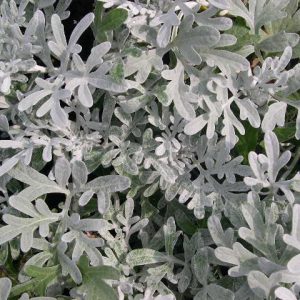
Host Plant – American Lady
Features to Note:
General Information:
Artemisia are prized for their aromatic silver leaves, excellent texture and vigorous growth. This perennial does not flower conspicuously but are used for their contrasting foliage. Also excellent in flower arrangements.
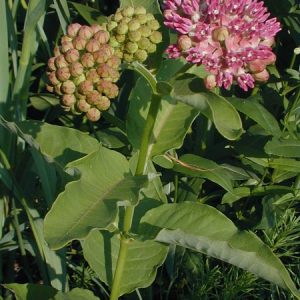
USA: AR, CT, DC, DE, GA, IA, IL, IN, KS, KY, LA, MA, MD, MI, MN, MO, MS, NC, NE, NH, NJ, NY, OH, OK, PA, RI, SD, TN, TX, VA, WI, WV
Asclepias purpurascens – Purple Milkweed is a Michigan native milkweed and is native to most of the eastern United States though it is uncommon to rare in cultivated gardens. Similar to Ascelpeias syriaca (Common Milkweed) it is an excellent garden choice due to its non-invasive nature. It has a long bloom season and the fragrant, intense rosy pink flowers attract numerous insects and butterflies. Purple Milkweed is very tolerant of a wide variety of soils and light levels making it easy to grow. It will tolerate shade, but blooms better in the sun. It commonly occurs in dry to moist open woods, dry ridge tops, thickets, glades, prairie openings, stream banks and wet meadows.
All of our plants are grown without the use of harmful pesticides and are safe for developing larvae.
Grown in 4.5″ square pot.
Available mid-late June 2017
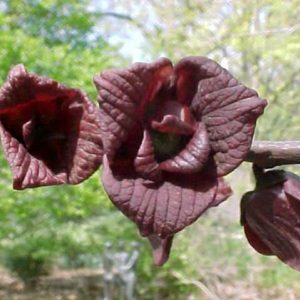
Easily grown in average, medium to wet, well-drained soil in full sun to part shade. Prefers moist, acidic, fertile soils. Will grow in shade but becomes leggy.
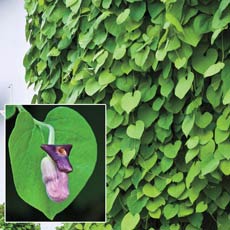
Host Plant – Pipevine Swallowtail
Culture
Easily grown in average, medium, well-drained soil in full sun to part shade. Prefers rich, moist soil. Intolerant of dry soils. Cut back in late winter to control growth. Grows well from seed.
This deciduous, woody, climbing vine is an eastern American native which typically occurs in the wild in rich, moist woods and along streams. Can rapidly grow to 20-30′. An old-fashioned favorite that is grown for its large, heart-shaped, densely overlapping leaves (6-12″ long) which can quickly cover an arbor or trellis with attractive, glossy, deep green foliage. Commonly called Dutchman’s pipe because the unusual, 2″ long, yellowish-green flowers (each flaring at the calyx mouth to form 3 brownish-purple lobes) superficially resemble Dutch smoking pipes. Although the flowers make interesting conversation pieces, they are usually hidden by the dense foliage and are somewhat inconspicuous.
Our 2024 plant list will be available in mid-Febrary 2024. Orders will begin to ship in May - June 2024 Dismiss
